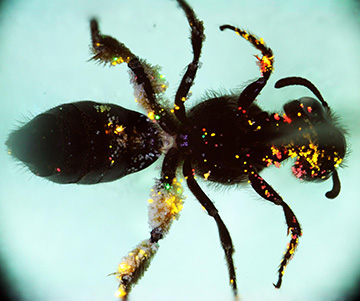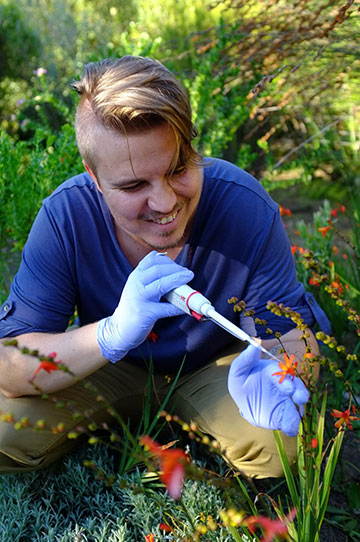
A bee, caught after visiting a flower whose pollen grains had been labelled with quantum dots. The glowing dots show evidence of the bee’s travels, and how the pollen attaches to it, when the insect is examined under the microscope in UV light. [Image: Corneile Minnaar]
A particularly sobering aspect of global environmental degradation is the rapid decline of insect populations. One recent study in the journal Biological Conservation estimated that 40 percent of the world’s insect species could go extinct within the next three decades, owing to habitat loss due to agriculture and urbanization, pesticides, climate change and other insults.
Quite apart from playing havoc with the food web, declines in certain insect populations threaten the bugs’ crucial role as pollinators. Humans rely on insects to pollinate more than 30 percent of food crops—a huge service that nature provides free of charge.
That makes it essential to understand which insects are pollinating which plants—even to the point of tracking individual pollen grains from flower to flower via their insect vectors. But a robust, useful system for labeling the tiny grains, which are subject to the vicissitudes of wind and weather in addition to the mazy paths of insects, has been fiendishly difficult to devise. Now, a pollination biologist in South Africa has hit upon a novel answer: tag the pollen with fluorescent quantum dots (Meth. Ecol. Evol., doi: 10.1111/2041-210X.13155).
Dots, flowers and pollen
Quantum dots (QDs) are luminescent semiconductor nanocrystals that, when excited by light of a specific wavelength (such as UV), re-emit at visible wavelengths, with the specific emission wavelength depending on the size of the quantum dot. They’ve found use in a wide variety of contexts including biomedical study (see, “Quantum Dots for Biomedicine,” OPN, April 2017). Indeed, the pollination biologist behind the new study, Corneile Minnaar of Stellenbosch University, South Africa, reportedly got the idea for pollen tracking with QDs from a paper on their potential use in targeting and imaging cancer cells.

Corneile Minnaar, applying a solution of lipid-tagged quantum dots to the business end of a flower. [Image: Ingrid Minnaar]
To use QDs to track individual pollen grains, Minnaar—who began the work as a Ph.D. student at Stellenbosch, where he’s now a postdoc in the lab of pollination biologist Bruce Anderson—first had to figure out how to tie the dots to the pollen. To do so, he began with commercially available, nontoxic CuInSexS2−x/ZnS (core/shell) QDs with four different emission wavelengths: 550 nm (green), 590 nm (yellow), 620 nm (orange) and 650 nm (red). Next, Minnaar chemically tied the QDs to an oleic‐acid ligand molecule that would latch onto the lipid-rich “pollenkitt” that surrounds pollen grains—the same substance that makes pollen stick to the coats of pollinators like honeybees.
Minnaar then took the lipid-doped QDs and dissolved them into a volatile hexane solvent, and micro-pipetted drops of the solvent onto the pollen-rich anthers on flowers of four different plant species. The ligand-bearing QDs quickly stuck to the pollenkitt on the grains, as expected, and the volatile hexane rapidly evaporated away. The result: flowers packed with potentially trackable, QD-labeled pollen.
Building an “excitation box”
The next problem to be solved was how actually to read the signal from the tagged pollen. While Minnaar says he started with a toy pen with a UV LED light to excite the fluorescence in the dots, he clearly needed something a bit more scalable. To get there, he used a 3-D printer to create a black “quantum-dot excitation box” that could fit under a dissection microscope, and that included four commercial UV LEDs, a long-pass UV filter, and supporting housing. In a press release accompanying the work, Minnaar said the UV box could “easily be 3D-printed at a cost of about R5,000 [around US$360], including the required electronic components.”
Minnaar tested the ability of the pollen grains to hold onto the QDs by agitating samples in an ethanol solution, and found that the grip was firm. Also, in a controlled, caged experiment, he trained honeybees to move from tagged to untagged samples of a particular flower species, and found that labeling the grains with the QDs had no effect on the grains’ ability also to stick to the bees.
Robust system
The general robustness of the system suggests it could serve well in tracking pollinators in wild settings, quantifying parameters such as pollen loss and the importance of certain species to sustaining specific kinds of plants. That said, there are still a few limitations, according to the paper. One is that right now, “there are only four commercially available, distinguishable quantum dot colors in the visible range,” which could limit studies to only four plant species at a time. And, while initial tests were encouraging, more work needs to be done to determine whether the labeling and application process has effects on pollen viability that could complicate experiments or affect pollinator behavior.
One other, unavoidable drawback, notwithstanding Minnaar’s clever microscope setup, is the sheer labor of counting and checking the glowing pollen grains to amass experimental data. That's a task likely to while away the hours of grad students for years to come, irrespective of the technique used to label the grains. “I think I've probably counted more than a hundred thousand pollen grains these last three years,” Minnaar said.
